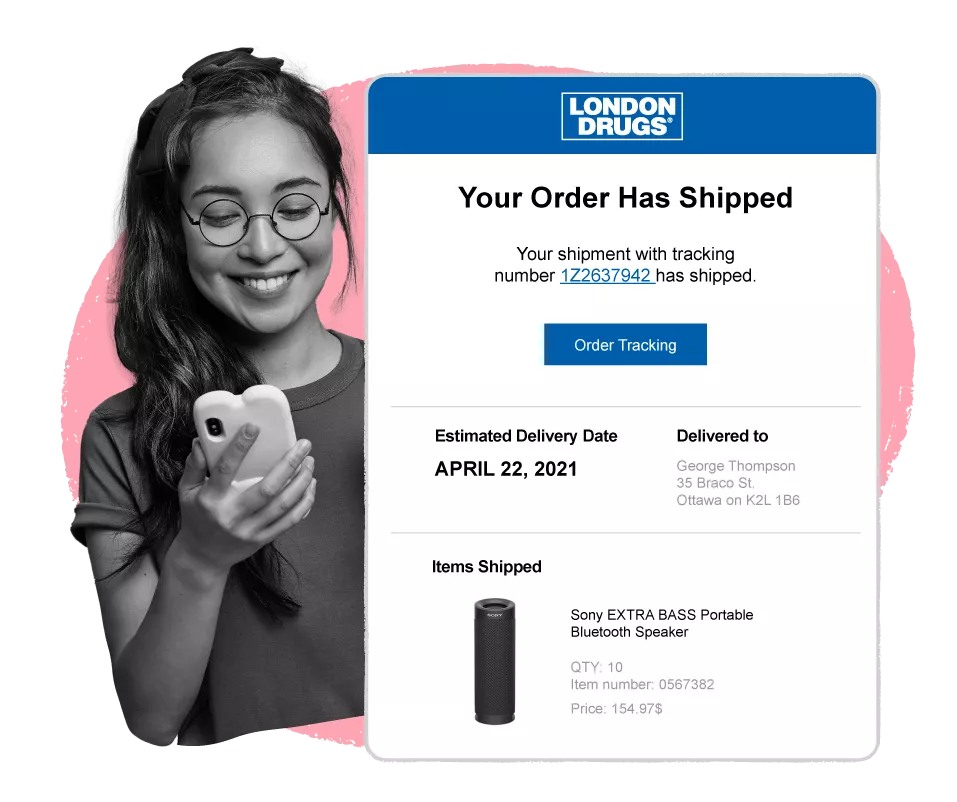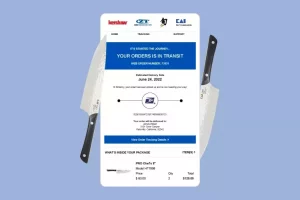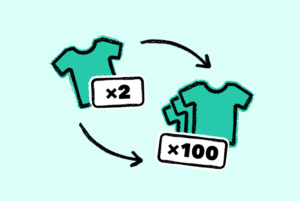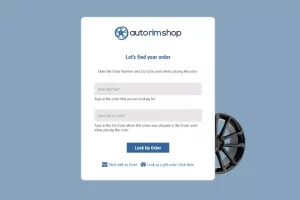
WooCommerce vs BigCommerce: Which one is right for your business?
BigCommerce vs WooCommerce: Which eCommerce platform works best for your business? Read this article to find out!
Shipping, Tracking & Notifications
Boost customer experience and reduce support tickets
Realtime order and shipment tracking
Proactive order and shipping notifications
AI-Enhanced Discounted Labels
Predictive pre-purchase estimated delivery dates
Self-Serivce branded order tracking
Effortless experience delivered
Identify and Resolve Order Issues
Realtime order and shipment tracking
Make returns profitable and delight customers
Flexibility to define any return destinations & conditions
Simplify returns for your customers and team
Incentivize exchanges over returns
Returns management made easy for your team
Returns management made easy for your team
Easy claims and smart upsells
Understand why your customers are returning
In-Store & Curbside Pickup
Unify the online and the in-store experience
Hassle-free pickup experience for customers
In-Store dashboard to keep operations streamlined
In-Store and Online orders unified
Drive foot-traffic to your stores
Shipping, Tracking & Notifications
Boost customer experience and reduce support tickets
Realtime order and shipment tracking
Proactive order and shipping notifications
AI-Enhanced Discounted Labels
Predictive pre-purchase estimated delivery dates
Self-Serivce branded order tracking
Effortless experience delivered
Identify and Resolve Order Issues
Realtime order and shipment tracking
Make returns profitable and delight customers
Flexibility to define any return destinations & conditions
Simplify returns for your customers and team
Incentivize exchanges over returns
Returns management made easy for your team
Returns management made easy for your team
Understand why your customers are returning
In-Store & Curbside Pickup
Unify the online and the in-store experience
Hassle-free pickup experience for customers
In-Store Dashboard to keep operations streamlined
In-Store and Online orders unified
Drive foot-traffic to your stores
Boost customer experience and reduce support tickets
Realtime order and shipment tracking
Proactive order and shipping notifications
AI-Enhanced Discounted Labels
Predictive pre-purchase estimated delivery dates
Self-Serivce branded order tracking
Effortless experience delivered
Make returns profitable and delight customers
Flexibility to define any return destinations & conditions
Simplify returns for your customers and team
Incentivize exchanges over returns
Returns management made easy for your team
Equip your team for precise return checks.
Easy claims and smart upsells
Understand why your customers are returning
Unify the online and the in-store experience
Hassle-free pickup experience for customers
In-Store Dashboard to keep operations streamlined
In-Store and Online orders unified
Drive foot-traffic to your stores
Find the answer to all your questions
Take a step by step trip through our functionality to see how we can improve your ecommerce processes.
Explore the most comon questions about WeSupply
Calculate the ROI that WeSupply can bring you
Read actionable articles on how to optimize your post-purchase experience and decrease support tickets
Get inspired by stories of how our customers implemented an effortless post-purchase experience
Wondering if WeSupply is a good fit for you? Read through our use cases to see how we can help you increase conversion & improve CX!
A Deep Dive into Top Companies' Order Tracking & Returns Strategy
Find the answer to all your questions
Explore the most comon questions about WeSupply
Calculate the ROI that WeSupply can bring you
Request a no strings attached review of your current shopping experience and missed conversion opportunities
Take a step by step trip through our functionality to see how we can improve your ecommerce processes.
Read actionable articles on how to optimize your post-purchase experience and decrease support tickets
Get inspired by stories of how our customers implemented an effortless post-purchase experience
A Deep Dive into Top Companies' Order Tracking & Returns Strategy
Wondering if WeSupply is a good fit for you? Read through our use cases to see how we can help you increase conversion & improve CX!
Choosing the right BigCommerce Fulfillment Center for your online shop can be challenging. Learn how you can make the right decision.

Starting an online store can be daunting, with all the options and choices available to new business owners. As a new eCommerce business, you may feel overwhelmed by the many fulfillment center options available for your BigCommerce store.
It can be hard to know which fulfillment center is right for your business, and even harder to ensure that your customers have a positive experience from pre-sale through post-purchase.
In this article, we’ll discuss how you can choose the order fulfillment center that meets your needs while exceeding your customer’s expectations, and what other tools and apps you can get directly from the BigCommerce Apps Marketplace to enhance your operations.
Fulfillment centers are an essential part of the eCommerce ecosystem. They are responsible for storing, packaging, and shipping products to customers on behalf of merchants— BigCommerce merchants in this situation.
Fulfillment centers are normally placed strategically in different locations to ensure that products can be delivered to customers quickly and efficiently. There are a number of BigCommerce fulfillment centers that use cutting-edge technology to streamline the fulfillment process, improve shipping and delivery time, and, alongside post-purchase tools like WeSupply, create a positive customer experience from start to end.
As the eCommerce landscape continues to evolve, BigCommerce fulfillment centers will continue to play a vital role in ensuring that merchants can meet the needs of their customers. No doubt, fulfillment centers offer a range of advantages for BigCommerce merchants, including:
By using a fulfillment center, sellers can offer a wider variety of products to their customers without having to worry about storing the items or shipping them themselves.
Fulfillment centers are designed to process large volumes of orders quickly and efficiently. By outsourcing order fulfillment to a center, businesses can be sure that their orders will be processed quickly and shipped out in a timely manner.
Fulfillment centers typically have a large workforce that is dedicated to filling orders and preparing them for shipment and often use sophisticated software to automate order processing and minimize errors, which naturally leads to faster processing time.
When you outsource fulfillment to a third-party provider, you eliminate the need to hire, train, and manage your own staff. Instead, the fulfillment center will handle all aspects of order processing, from receiving and picking to packing and shipping.
Fulfillment centers enable brands to outsource their logistics operations and free up precious time that can be used more productively on marketing and sales activities that often bring a higher ROI.
By outsourcing order fulfillment operations, businesses can eliminate the need to maintain a physical location for housing and processing orders. There’s no need to store large amounts of seasonal products or handle inventory yourself, as a merchant.
There are a few potential disadvantages of fulfillment centers that you should be aware of before outsourcing your order fulfillment.
While most fulfillment centers have safeguards in place to minimize these risks, they cannot be completely eliminated. That is why it’s advised to weigh the pros and cons of using a fulfillment center before making a decision. Here are the most common disadvantages of fulfillment centers:
While fulfillment centers can take a lot of the work off your hands, they do charge fees for their services. For example, most fulfillment centers will charge a flat fee to integrate your store with their system. In addition, they might also charge a fee for each order that they process.
Fulfillment centers are their own entities, with their own policies and procedures. Brands have little control over how fulfillment centers manage orders and cannot intervene during the order fulfillment process. This asks for powerful post-purchase solutions like WeSupply, that enable you to provide your customers with proactive notifications, order tracking, and self-service returns.
Although fulfillment centers can normally process orders faster, the time it takes to ship an item from a center to the customer depends on where the center is located. This could cause shipping times to be longer than expected. Another factor that can lead to shipment exceptions is if the seller is unable to quickly replace an out-of-stock product.
Some BigCommerce fulfillment centers might have their own drawbacks, they can surely be a valuable asset for eCommerce businesses that are looking to streamline their operations but also for merchants who lack the capability of managing their own inventory (including dropshippers).
See how WeSupply helps eCommerce websites build premium post-purchase experiences!


See how WeSupply helps eCommerce websites build premium post-purchase experiences!
When a merchant sells an item on their BigCommerce store, they can choose to have the order fulfilled by a BigCommerce fulfillment center partner. Fulfillment centers on BigCommerce generally receive, store, process, pick, pack, and ship orders on behalf of Bigcommerce merchants.
Besides offering fulfillment center options, merchants can also find on the BigCommerce Apps Marketplace tools that complement fulfillment services, including order management, tracking, and reporting.
However, other order processing activities remain the responsibility of the seller. Although most fulfillment centers also take care of inventory management, you might still need to handle that part on your own. Besides inventory levels, you might also need to have your own order management system in place.
Moreover, if customers receive the wrong order, the seller will need to contact them to fix the problem. Payment must be handled separately from the fulfillment process since most fulfillment providers do not offer payment processing as a service.
The terms “fulfillment warehouse” and “fulfillment center” are sometimes used interchangeably, but they’re not the same— in fact, fulfillment centers are much different from traditional warehouses.
A traditional warehouse is a place where you can store your inventory for a longer period of time, often taking it challenging to access inventory. However, it’s a fantastic solution if you’re selling seasonal products and you need long-term storage space.
Moreover, traditional warehouses do not offer services such as packing, labeling, packaging, or shipping, unlike fulfillment centers. In contrast to warehouses, fulfillment centers store inventory for a shorter period of time before shipping it to customers the instant orders are placed.
Here’s a breakdown of the main perks and disadvantages of both warehousing and fulfillment centers:
Warehouse:
Great for storing items long-term
Gives you control over shipping costs
Management requires time and effort
Fulfillment Center:
Reduced storage and staffing expenses
Improved business scalability
Little control over processing time
The first step is to find the right fulfillment provider. Look for the one with physical locations that are the closest to your target audience and whose fees align with your current budget.
Are you looking for a flat rate shipping? Would you rather sign with a fulfillment center that can offer free shipping? Do you want to do your own inventory management for your online business?
These are only a very few questions to begin with when deciding on the right fulfillment center for your online BigCommerce shop.
Here’s our 5-step decision-making framework to help you pick the best option:
Look at your order fulfillment operations and pinpoint any cracks in your strategy. Decide what are your priorities and what areas in your order fulfillment process need a helping hand.
Are you short-staffed? Are you capable of managing your own inventory? Is that a priority for you? Would it be more cost-effective and time-efficient to outsource inventory management as well?
If you’re a dropshipper, do you need your order fulfillment center to also provide you with the merchandise? Are you working with external manufacturers or wholesale suppliers instead?
Next up, decide what are your main long-term and short-term goals.
Are you looking for ways to increase revenue? Do you want to free up precious time that could have been used more efficiently in other areas and departments of your business?
How is a fulfillment center going to help our company meet our objectives?
Change is the only constant, so make sure you set SMART (Sustainable, Measurable, Attainable, Relevant, Timely) goals and review them whenever necessary.
You can explore a variety of BigCommerce shipping and fulfillment centers before making a decision.
Start by looking at pricing, benefits, limitations, usability, and customer service. Chances are you’re looking for proactive, problem-solving, customer-oriented partners in your journey. This is exactly why you need to analyze several available options before sealing the deal. You can even create a list of must-have and nice-to-have features, discuss the issue with external experts, and ask for employee feedback.
Life isn’t all sunshine and rainbows.
And, as cliché as it might sound, you need to expect the unexpected and be prepared.
Look at the potential disadvantages and downsides of going for a fulfillment center, and see how you can avoid or overcome any obstacles thrown your way, including things that are not within your scope of control (e.g., shipment exceptions and delays).
There’s nothing like learning from experience— things might look good on paper, but you might see different results than what you’ve expected.
It that’s the case, try to understand what are the main causes of this discrepancy between expectations and reality, discuss matters with your employees who come across these processes on a daily basis, and try to look at the issue from their perspective. Put yourself in your customers’ shoes and try to comprehend their experience ordering from you. Once you gather all this information, start the process over.
As mentioned above, although fulfillment services come with a lot of advantages, there are also certain downsides and areas that might need improvements— from order tracking and delivery notifications to returns management and store credit. Fortunately, WeSupply can help you take your post-purchase operations to the next level while ensuring a positive and memorable customer experience.
WeSupply allows a seamless integration with BigCommerce in just a few clicks. All you have to do is to install the WeSupply app on the BigCommerce Apps Marketplace and import your orders.
Once you’ve completed these steps, WeSupply enables you to:
You can save hours each week by automating the order tracking process, enabling customers to take the matter into their own hands. If customers can track their package at all times, there’s no need to contact your customer care team with “Where is my order?” type of questions.
Communicate with your customers throughout the journey and automatically update them whenever necessary. Let them know when you’re encountering situations such as orders stuck in transit, backordered, and so on, to mitigate any post-purchase anxiety.
70% of shoppers want a frictionless eCommerce returns experience. WeSupply enables you to give them complete control over the return process in just 3 simple steps. Moreover, customer support reps can also manually review return requests when necessary.
When it comes to BigCommerce order fulfillment centers, you’ve surely got a variety of options you can choose from.
But before making your decision, make sure you go over all the perks and disadvantages of all solutions. After all, choosing a fulfillment center is a long-term commitment for your business and your customers.
Follow the steps above to have a better understanding of your order fulfillment and inventory management needs, and make well-informed decisions that can help you boost revenue and increase your profit margin over time, but also lead to happier customers.
Last but not least, it’s important to keep the customer in mind at all times. After all, most successful businesses (including Amazon) are highly customer-centric, focusing on the customer experience from the first visit to their website (through personalization or estimated delivery dates) to the moment of checkout and everything that comes after.
See how WeSupply can help! Watch our platform in action to convince yourself.
Learn How To Create Successful Post Purchase Email Campaigns
Build post-purchase email flows to drive customer satisfaction and revenue growth!

BigCommerce vs WooCommerce: Which eCommerce platform works best for your business? Read this article to find out!

The LimeSpot team rounded up for you 9 smart ways to engage first-time shoppers and keep them coming back for more. Keep reading here!

BigCommerce vs Shopify: Which platform works best for your business and what to consider before signing up for either? Find out in this article!

What is churn rate, how does it affects retail businesses, and how can you reduce it with effective post-purchase strategies? Find out here!

Shopify SMS marketing done right! See how to integrate your SMS marketing apps for Shopify to build a successful post-purchase strategy.

Keep reading to find out how Kai USA managed to remove 92% of order-related support inquiries using WeSupply as their post-purchase platform.

What is the Minimum Order Quantity or MOQ? Meaning and everything you need to keep in mind before sealing the deal with a supplier.

What does backordered mean and how does this affect your retail business? Check out this article to find out!

Auto Rim Shop automates the Delivery and Return Experience for heavy items fulfilled and returned directly to dropshippers.